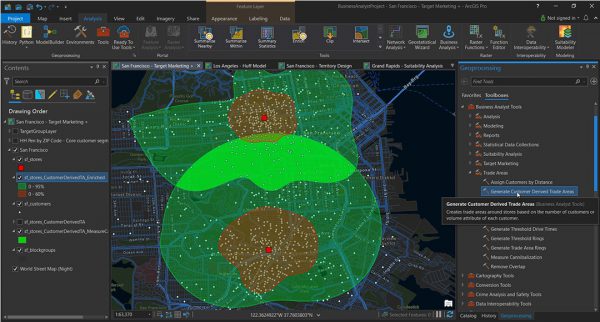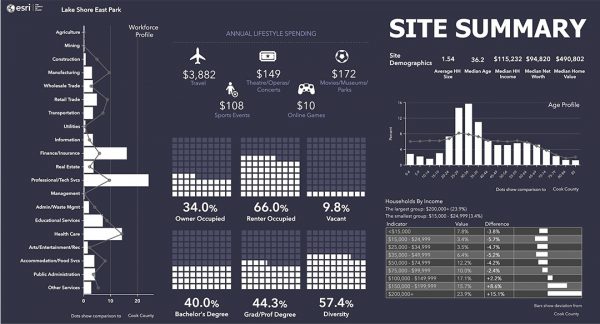
21 Sep Commercial Real Estate Firm Enhances Business Site Selection with Analytics Tool
Mid-America Real Estate Group, headquartered in Oakbrook Terrace, Illinois, with additional locations in Chicago, Detroit, Milwaukee, and Minneapolis, specializes in commercial real estate, offering tenant and property representation and investment sales as well as property management services. Mid-America cultivates strong partnerships with retailers, landlords, owners, and brokers across the Midwest, helping match businesses to locations where they are likely to thrive, also known as site selection.
With a wealth of consumer and demographic data available to brokers, the industry evolved beyond simply matching a business to a physical space—real estate firms now account for issues like trade area competition, business cannibalization, drive times, and population demographics and income to ensure the best chance of success for their clients’ new locations.
But brokers need to be able to communicate this data to their clients in a clear and compelling way that inspires trust in their selection methods. Mid-America implemented a mapping solution with powerful analytic tools that allows its brokers to access and analyze the data that is most important to their clients’ site selection. Using this solution has allowed Mid-America to revitalize its previous paper map-based workflows with an interactive, digital platform that provides the data accuracy it needs.
Challenge
David Semitekol, GIS coordinator for Mid-America, was heavily involved in the implementation of new digital workflows to address Mid-America’s central challenge: finding the best sites possible to match its clients’ needs and increase the chance of success for the proposed new locations.
Semitekol explains that identifying and filling physical vacancies are only part of the equation; Mid-America needs to work with its clients to understand their customer bases and find locations that can support their projected expansion.
“In today’s world, it’s more of understanding really what’s going on inside a given area—everything from demographics to population age, household income to even occupational work statuses,” says Semitekol. “We’re challenged with questions like, Do we have cannibalization? How far is the customer willing to travel?”
A second challenge Mid-America wanted to address was transitioning from its paper map-based workflows to a digital platform; Mid-America wanted to revitalize its services to provide clients with a deeper, more interactive understanding of their business site options, ensuring that it could always find the perfect fit to maximize a client’s success. Mid-America needed a solution that would provide the data, accuracy, and analytics required for site selection in a format its clients could meaningfully engage with in an interactive way.
Solution
These challenges of accurate site analysis and digital transformation were the baseline incentives that inspired Mid-America’s decision to revitalize its workflows with a new digital mapping and analytics product.
In 2018, Mid-America deployed ArcGIS Business Analyst to provide interactive, data-rich insights to its clients through analytic tools built into a web map platform. ArcGIS Business Analyst combines consumer data such as spending habits and demographics with map-based analytics, making it a powerful tool to support site selection and business planning.
Semitekol collaborated closely with Mid-America brokers to identify their needs, ensuring that the new workflows could help ramp up the quality and accuracy of their site selection services and make stronger pitches to clients in the commercial and retail space. Coming from a paper map-based system, it was important that the brokers were able to make a smooth transition to a digital format and continue serving their clients effectively.
Results
What happened next proved that Mid-America was entering new and exciting territory with the new digitized workflows. “We saw a shift in the client meetings,” Semitekol reports. “A couple of months ago, we went to visit a brand-new client, and we were able to build a simple custom web app that showed their current branch locations and how we were able to run analytics on their current customers, and we were able to plot a couple of proposed locations.”
The response brokers received from this client was overwhelmingly positive and a milestone indicator of their success with the product. “The CEO and CFO got up from their chairs and walked over to the monitor. It was no longer a one-on-one discussion—it was an interactive discussion that we were having with the client,” says Semitekol.
The implementation of ArcGIS Business Analyst blended Mid-America’s newfound capabilities in geographic information system (GIS) technology with the industry knowledge of its brokers. This has not only allowed Mid-America to digitize its paper-based workflow but also to pass real value to its clients through the highly accurate demographic and population income data it can provide with ArcGIS Business Analyst.
The new workflows that Mid-America has developed represent harmonious cooperation between real estate brokers and the GIS team. Now, brokers can approach the GIS department with information about the clients’ target demographics, and the GIS department can leverage the new analytic tools to select the best sites for new locations—with the added benefit of analyzing trade areas for voids, cannibalization, drive times, and more.
“We represent a myriad of clients including grocers, discount retailers, fast-casual concepts, and entrepreneurs,” Semitekol explains. To capture the nuanced needs of each individual client, brokers need accurate data and effective tools with which to analyze it—which they’ve found in ArcGIS Business Analyst.
Semitekol points to Void Analysis, a tool recently added to ArcGIS Business Analyst, as a kind of Rosetta Stone for Mid-America, enabling it to provide unprecedented value for its existing client base. By proactively running analyses of promising trade areas for client expansion, Mid-America can breathe new life into its existing client base by reaching out to clients with tailor-made recommendations for potential new locations.
Rather than wait for clients to demonstrate interest in obtaining new sites, Mid-America can now inspire that interest itself. Once Mid-America has identified the voids, it’s a simple case of calling up clients to make recommendations, and so far, the response has been very positive. “It gives us a targeted list to start calling the clients to say, ‘Hey, we’ve noticed that you’re not in this area, and we’ve got a perfect store location for you that’s matching your demographics,’ so that’s been really exciting for them,” Semitekol says.
Another tool that Mid-America has found helpful is the Threshold Analysis tool, which allows brokers to further identify voids of service areas inside a given trade area. Semitekol describes an example workflow that allows them to display a client’s existing locations first, identify potential new locations, and then run their analysis against the client’s success metrics.

“We know the client needs at least 75,000 people in a given area for that store to prosper, so we can plot the current locations and the proposed locations, calculate a drive time that includes a consumer base of 75,000, and have ArcGIS Business Analyst automatically calculate the distance,” he explains.
Once they can see the locations that aren’t already being covered by the drive time areas, Mid-America brokers can bring those options to the client with full confidence that the areas’ populations can viably support the proposed new locations, while adhering to the client’s metrics for success. “Not only do we propose these five new locations,” Semitekol concludes, “but we actually find two other locations that are going to fill these holes.”
Semitekol also emphasizes that tools like this make a critical difference for small businesses and franchisees for whom expansion can represent substantial financial risk compared to larger chains.
“For the smaller retailers who are putting everything into one or two locations, it’s reassuring them that when we find that location, that it has a higher probability of success,” he says. “The data being provided gives them every assurance that it’s a good location for them.”
Semitekol and his colleagues couldn’t be happier with the improvements they’ve made to Mid-America’s service offerings. Dan Cohen, the principal director of Tenant Representation of Mid-America Wisconsin, reported that “implementing ArcGIS Business Analyst has been pivotal in providing our clients [with] the data to help them make informed decisions. Combining our 35-year market knowledge with the capabilities of Esri allows us to look at the data from a 360 viewpoint.” Clients know they can trust Mid-America to find the perfect sites for their business locations, and now the firm has the resources to streamline and strengthen its internal operations as its GIS department grows to support them.
“ArcGIS Business Analyst is really helping us to understand and to see what we’ve not been able to see before. It’s helping to set us apart from a very crowded field of competitors.”
David Semitekol Mid-America Real Estate Group
Unleashing GIS Technology’s potential in every industry

